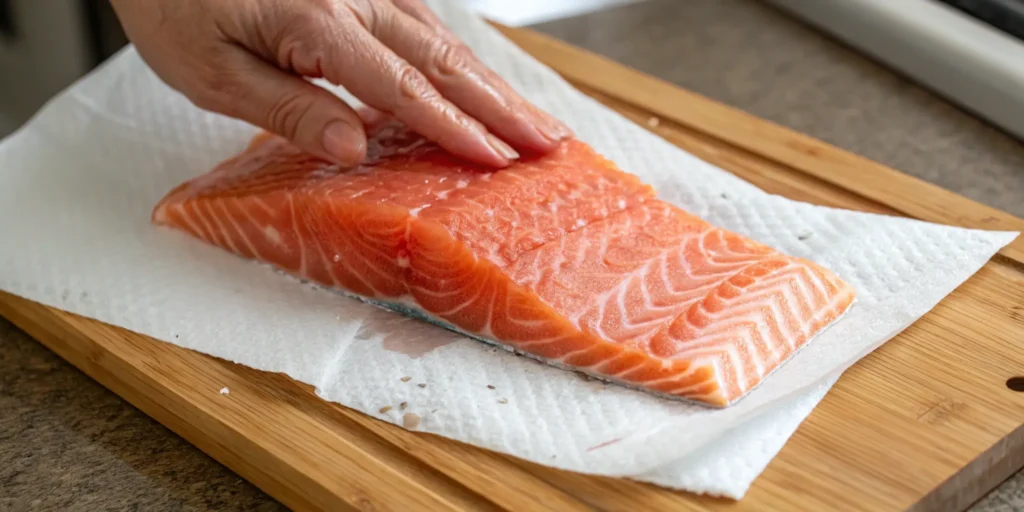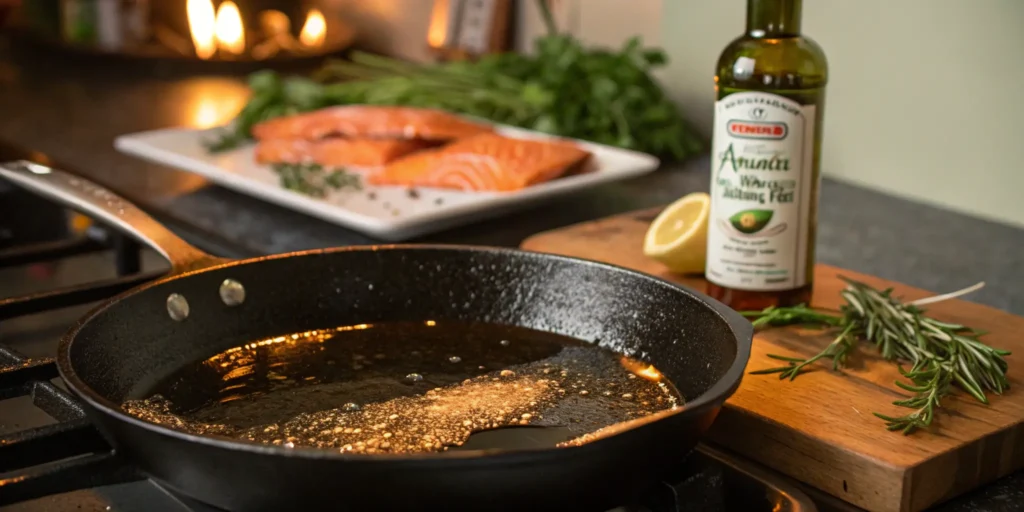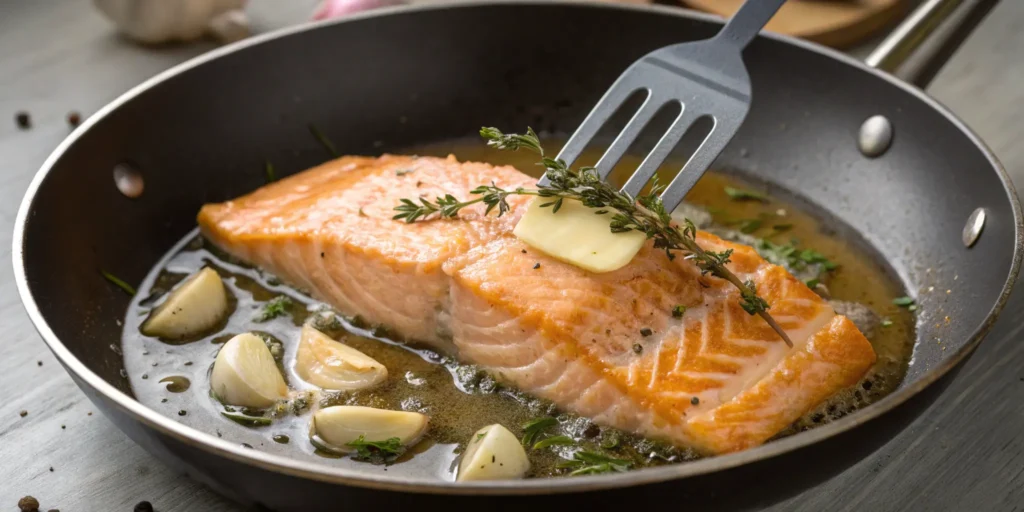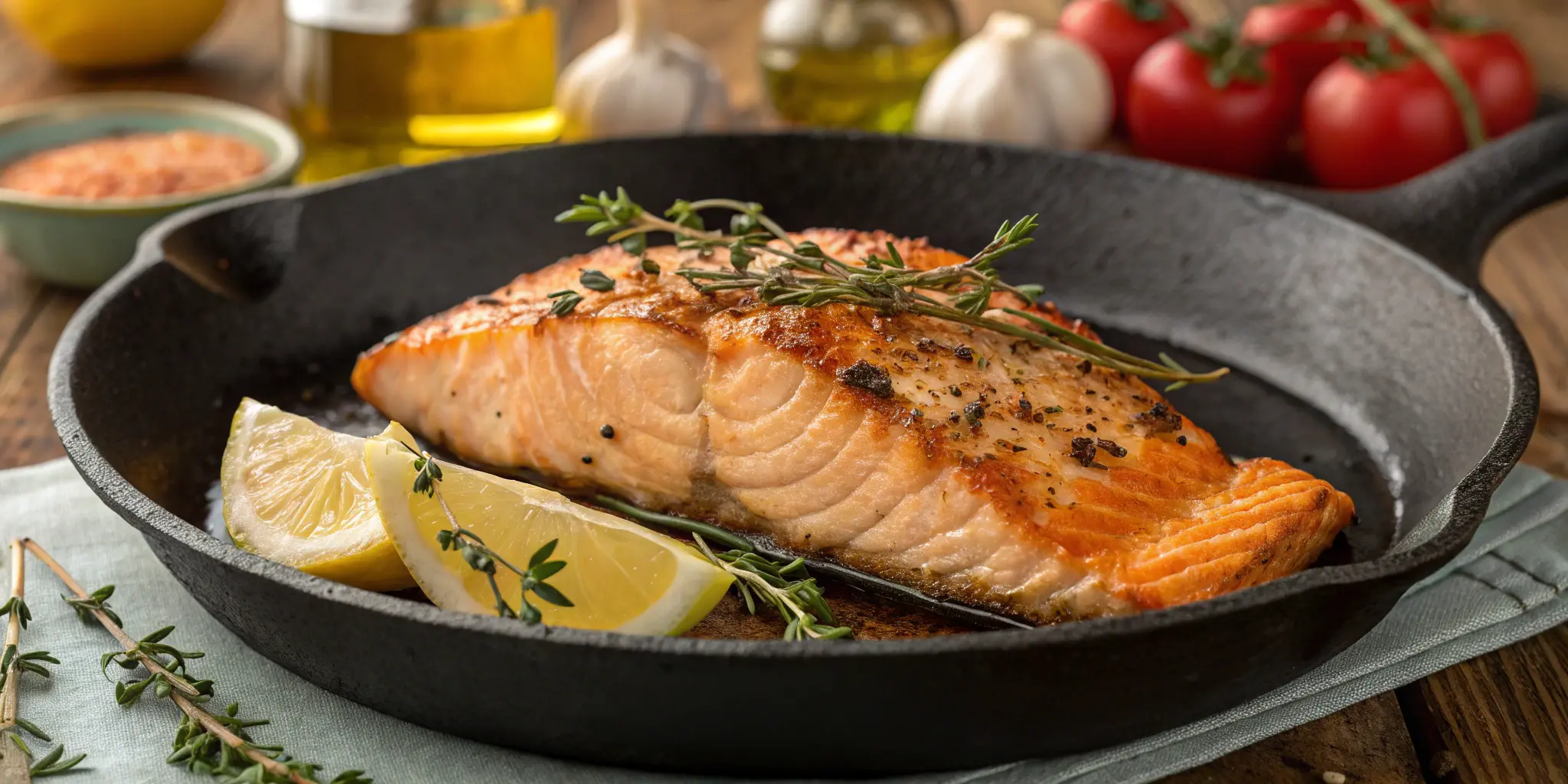Pan Fried Salmon: 3 Simple Tricks for Perfect Crispiness
Table of Contents
The First Time You Nail That Crispy Pan Fried Salmon…
You’re standing in your kitchen, holding a fillet of salmon that practically begs to be transformed into something memorable. You’ve tried before—maybe more than once. The skin stuck to the pan, the inside turned out dry, or the whole thing just didn’t look like the golden-crusted beauty you saw online. That moment can be disheartening. But here’s the good news—you’re not alone, and better yet, you’re just a few steps away from mastering it.
That’s the thing about pan fried salmon. It looks deceptively simple, yet achieving that perfect balance of a crispy skin and tender, flaky interior takes more than just tossing it in a hot pan. The flavor, the texture, the satisfaction of slicing through the crackling skin with your fork—it’s something you remember. And it’s something you can absolutely replicate in your own kitchen.
In this guide, you’ll discover three simple yet powerful tricks that will change how you cook salmon forever. Whether you’re cooking for yourself, your partner, or a dinner party of friends, once you master these methods, you’ll wonder how you ever did it any other way.
Why Crispy Pan Fried Salmon Is Worth It
There’s a reason why crisp-skinned salmon is the go-to choice at so many restaurants. And no—it’s not just about aesthetics.
- Texture contrast: That satisfying crunch followed by juicy flakes offers a bite that’s nothing short of addictive.
- Flavor boost: The searing process brings out deep, savory notes from the skin and locks in moisture.
- Healthy indulgence: You get high-quality protein and omega-3s, minus the extra oil or heavy breading.
You don’t have to settle for bland or rubbery salmon. When done right, pan fried salmon becomes the hero of your dinner table—elegant, delicious, and surprisingly easy to get right once you know what to do.
Choosing the Right Cut for Crispiness
You can’t create restaurant-quality results without starting with quality ingredients. And the cut of salmon you choose makes all the difference when it comes to achieving that pan-seared crust.
What to Look For:
- Skin-On Fillets: Always go for skin-on. The skin acts like a protective layer, helping to retain moisture and build that crisp shell.
- Even Thickness: Uniform thickness helps with even cooking. Look for center-cut fillets that are neither too thick nor too thin.
- Wild vs. Farmed: Wild salmon tends to be leaner, while farmed has more fat content. For crispiness, farmed salmon gives you a bit more leeway.
Buying Tips:
- If you’re buying fresh, smell it. It should have a clean, ocean-like scent.
- Ask your fishmonger to remove any pin bones, but keep the skin intact.
- For frozen, make sure the fillets are vacuum-sealed and free of ice crystals.
Pro Tip: Let your salmon come to room temperature before cooking. Cold fish going into a hot pan tends to seize up and cook unevenly.
Trick #1: Start With Dry Salmon
It sounds simple, but moisture is the #1 enemy of crispiness.

Why It Matters
When you place wet salmon into a hot pan, the water creates steam. Steam = sogginess. For the salmon to crisp, the skin needs to contact the oil directly, not a layer of moisture.
How to Do It Right
- Pat It Down: Use paper towels to blot both the skin and flesh sides of the fillet.
- Air-Dry Optional Bonus: Place your salmon uncovered in the fridge for 30–45 minutes before cooking. This draws out surface moisture and firms up the flesh.
- Season Last Minute: Salt draws out moisture over time. Season your fillet just before it hits the pan, not 30 minutes before.
Food Science Bonus: The Maillard reaction—responsible for browning—can’t happen in the presence of water. Removing that moisture is key to flavor and texture.
Trick #2: Use the Right Pan and Oil
Choosing the right tools isn’t just a preference—it’s a necessity for that restaurant-style crust.

Your Pan Matters
Not all cookware is created equal. Here’s what works best for pan fried salmon:
- Cast Iron: Retains heat like a champ. Great for even searing and crust formation.
- Stainless Steel: Also a solid choice, as long as you let it heat up properly. Salmon will naturally release from the surface once seared.
- Avoid Non-Stick: These pans don’t get hot enough, and you’ll often end up with soft, pale skin instead of crisp.
Best Oils for Crispy Salmon Skin
You need oil with a high smoke point—which means it can handle high heat without burning.
- Avocado oil (smoke point: ~520°F)
- Grapeseed oil (~420°F)
- Canola oil (~400°F)
Avoid extra virgin olive oil—it burns too quickly and can leave a bitter aftertaste.
Heat Management
- Preheat your pan before adding the oil.
- Once the oil is added, wait until it shimmers—not smokes—before placing your salmon.
- Test by flicking a drop of water into the oil—it should sizzle and evaporate instantly.
Golden Rule: Never put cold salmon into cold oil in a cold pan.
Trick #3: Master the Flip and Finish
This is where good pan fried salmon turns into great pan fried salmon.

Start Skin Side Down
- Place your fillet in the pan skin-side down and press it gently for 10 seconds with a spatula. This ensures even contact.
- Let it cook—undisturbed—for 5 to 6 minutes, or until the skin naturally lifts off the pan without resistance.
Flipping Technique
- Use a fish spatula—it’s thin and flexible enough to get under the fillet without tearing.
- Flip gently and cook for just 1–2 more minutes on the flesh side.
- Don’t overdo the second side—you’re not trying to sear it all the way through.
Butter Basting (Optional, But Incredible)
Add a tablespoon of unsalted butter to the pan, along with:
- A few smashed garlic cloves
- A couple sprigs of fresh thyme or rosemary
Tilt the pan slightly and spoon the melted, infused butter over the salmon for the last minute of cooking. This adds richness, aroma, and a restaurant-level finish.
Up Next: The Full Recipe with Ingredient Table + Step-by-Step Instructions
In Part 2, you’ll get:
- The pan fried salmon recipe laid out in a visual table
- Full instructions you can follow with confidence
- Bonus: Serving suggestions that take your plate to the next level
Simple Pan Fried Salmon Recipe
Ingredients Table (H3)
| Ingredient | Quantity | Notes |
|---|---|---|
| Skin-on salmon fillets | 2 (6 oz each) | Pat dry thoroughly before cooking |
| Kosher salt | To taste | Season just before cooking |
| Freshly ground black pepper | To taste | Adds subtle heat and flavor |
| Avocado oil | 2 tbsp | High smoke point for crisp skin |
| Unsalted butter | 1 tbsp | Optional, for basting |
| Fresh thyme sprigs | 2 | Optional, adds aromatic flavor |
| Garlic cloves | 2, smashed | Optional, for butter basting |
| Lemon wedges | For serving | Adds brightness and acidity |
Step-by-Step Instructions (H3)
- Prepare the salmon
Remove the fillets from the fridge 15-20 minutes before cooking to reach room temperature. Pat both sides dry with paper towels. Season lightly with kosher salt and freshly ground pepper. - Heat your pan and oil
Place a cast iron or stainless steel pan over medium-high heat. Once hot, add avocado oil and wait until it shimmers but does not smoke. - Place salmon skin-side down
Carefully lay the salmon fillets in the pan skin-side down. Press gently with a spatula for about 10 seconds to ensure full contact with the pan. - Cook undisturbed for 5–6 minutes
Let the salmon cook until the skin turns golden brown and releases easily from the pan. - Flip the fillets
Using a fish spatula, flip the salmon carefully. Cook on the flesh side for 1–2 minutes more until the salmon is just cooked through. - Optional butter baste
Add butter, smashed garlic, and thyme to the pan. Tilt the pan and spoon the melted butter over the salmon for 1 minute to add flavor and moisture. - Rest and serve
Remove the salmon from the pan and let it rest for 2 minutes. Serve with lemon wedges for a fresh pop of acidity.
Serving Ideas to Elevate Your Pan Fried Salmon
Pairing your crispy salmon with the right sides transforms a simple meal into a complete dining experience. Here are some crowd-pleasing ideas:
- Garlic roasted potatoes: Crispy on the outside, fluffy inside, seasoned with rosemary and garlic.
- Sautéed green beans or asparagus: Lightly cooked with olive oil and a squeeze of lemon.
- Quinoa salad: Tossed with fresh herbs, cherry tomatoes, and a light vinaigrette.
- Creamy dill yogurt sauce: Mix plain Greek yogurt with fresh dill, lemon juice, and a pinch of salt.
- White wine pairing: Sauvignon Blanc or Chardonnay complement the salmon’s flavors beautifully.
Common Mistakes to Avoid When Cooking Pan Fried Salmon
Learning what not to do can save you from frustrating outcomes. Avoid these pitfalls for crispy, perfectly cooked salmon every time:
- Flipping too soon: Patience is key. Let the skin crisp and naturally release before flipping.
- Using wet salmon: Moisture prevents a crust; always dry your fillets well.
- Cooking at low heat: Too low won’t crisp the skin, too high can burn it. Medium-high is ideal.
- Overcrowding the pan: Crowding traps steam, making skin soggy. Cook in batches if needed.
- Using the wrong oil: Low smoke point oils burn quickly and create off-flavors.
- Not seasoning properly: Salt enhances texture and flavor—don’t skip it.
Conclusion: Your Salmon Deserves the Best
You’ve now uncovered the secrets to making pan fried salmon with perfectly crispy skin and tender, juicy flesh every time you step into the kitchen. It’s all about understanding your ingredients, prepping carefully, and mastering the simple techniques that chefs swear by.
By drying your salmon thoroughly, choosing the right pan and oil, and mastering the flip and finish, you turn a humble fillet into a dish worthy of any dinner table — whether it’s a busy weeknight or a special occasion.
Don’t settle for anything less than the crisp, golden skin and flavorful, moist interior you crave. The next time you cook salmon, remember these tricks. You’ve got this.
Frequently Asked Questions About Pan Fried Salmon
Q1: What is the best oil for pan fried salmon?
Use oils with a high smoke point like avocado oil, grapeseed oil, or canola oil. They allow the salmon skin to crisp without burning.
Q2: Should I cook salmon with the skin on or off?
Cooking salmon with the skin on helps retain moisture and gives you that prized crispy texture. It also protects the flesh during cooking.
Q3: How do I know when my pan fried salmon is done?
The salmon is done when it flakes easily with a fork and has an internal temperature around 125°F (52°C) for medium-rare or 135°F (57°C) for medium.
Q4: Why does my salmon stick to the pan?
Salmon tends to stick if the pan isn’t hot enough or the fillet is wet. Pat your salmon dry and let the skin crisp up fully before attempting to flip.
Q5: Can I reheat leftover pan fried salmon?
Yes. Gently reheat in a skillet over low heat or in an oven set to 275°F (135°C). Avoid microwaving to keep the skin crispy.
Your Next Step: Start Cooking with Confidence
You have everything you need now to create pan fried salmon that’s crispy, juicy, and full of flavor. Why wait? Grab a fresh salmon fillet, prep your pan, and try these tricks tonight.
If you loved these tips and want to explore more recipes and cooking secrets that turn everyday meals into something special, be sure to check out my other guides and subscribe for more insider culinary know-how.
Don’t forget to share your success stories and photos! Let’s make crispy pan fried salmon a staple in your kitchen.

